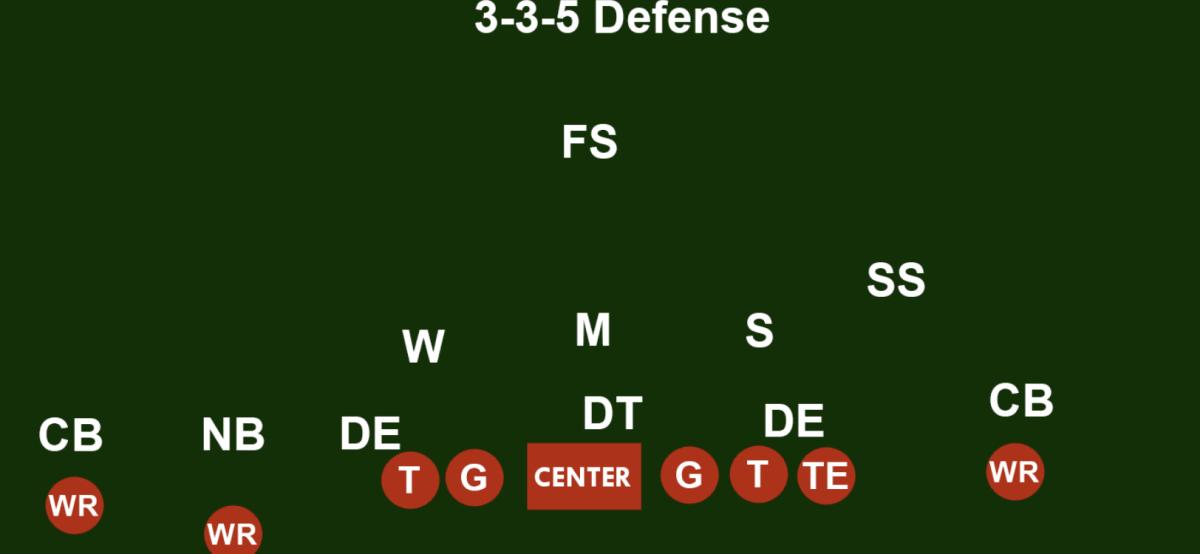What is the 3-3-5 Defense, and How Can it Work for UCF?

When the 3-3-5 defense started to come about, many traditionalists scoffed at the idea. It did, in fact, go through many trials and tribulations. That much would be fair. Where the traditionalists may need to adjust would be seeing the vast majority of college football programs now running this defense, at least occasionally, as part of their base defense.
The following will represent more than just what the 3-3-5 can be for UCF. The intent of this article will be to give a glimpse of how being multiple, as noted above, can change a defense and make it difficult for opposing offensive coordinators to scheme a game plan against the Knights. This is not a deep dive into the 3-3-5. That’s unnecessary as UCF Defensive Coordinator Travis Williams and the rest of the defensive staff still need to go through fall camp and eventually trot a starting lineup onto the field.
The 3-3-5 allows players to play to their strengths. With several players along the front four of the defense, as well as in the secondary, that could play multiple positions, the 3-3-5 could be very valuable as a weapon by way of moving players to different positions and attacking the line of scrimmage. Coach Williams made a comment regarding this point during his Aug. 5 press conference that every UCF fan should rejoice about:
“Whatever fits our guys, that’s what we are going to do.”
Sounds pretty simple, doesn’t it? Well, not all coaches think and communicate like Coach Williams. Many are stubborn and desire the players to adjust to the scheme no matter the talents of the players. Bad idea, but it happens frequently. As for UCF Football and potentially being a 3-3-5, here are some examples of what that may look like. Again, this is a work in progress.
Fall camp, as well as the regular season games and practices, will dictate which players play. With that, here are a few scenarios that should be discussed as it relates to why the 3-3-5 could potentially help UCF during the upcoming football season.
The following photo presents a basic look at a 3-3-5 formation

Defining the 3-3-5 and its Purpose
First off, most teams operate from a spread formation in some sense of the phrase. For the purpose of this category, “spread” means a pass-happy offensive philosophy. Think more of a Run and Shoot offense that was popular in the 1980s and 1990s, or what now departed Florida State Head Coach Bobby Bowden helped to engineer in Tallahassee, the Fast Break Offense. Four wide receivers jog into their formations, and now it’s time for the defense to stop them because a defense knows a passing game is coming.
A 3-3-5 already possesses an extra defensive back on the field. This extra defensive back will then line up and take a slot wide receiver one-on-one or perhaps blitz, and could even invert and move back into the deep secondary. This is just one example of how the 3-3-5 can be multiple in an attempt to stop opposing spread passing attacks.
That’s the benefit of the 3-3-5 defense. There will always be an extra defensive back to play “games” with and attempt to confuse an opposing quarterback and his intended targets. The idea is to create takeaways, i.e. turnovers that otherwise would not happen. A missed read or misunderstanding between the quarterback and his intended wide receiver could fall directly into the hands of a defensive back. The 3-3-5 will sometimes create an easy turnover simply because the offense was confused. Moving to the front seven, there are different ways to create opportunities for talented players.
Turning the Big Kat Loose
Defensive ends come off the edge and rush the passer. Regardless of scheme, this does not truly change. Well, sort of. Take UCF defensive end Big Kat Bryant as an example. He’s a really unique player because he could play standing up and attack the passer, he’s also physically gifted enough to line up in a weak side linebacker position and rush the passer as a blitzer, or just place his hand in the turf and play a head-up defensive end position over an offensive tackle. The possible answers are intriguing, and that helps other UCF defensive lineman as well (see below).
We shall see what Coach Williams and his staff do with Bryant, but the 6’5”, 245-pound talent from Cordele (Ga.) Crisp County by way of Auburn should be a unique piece to the Knights defensive formations in general, with the 3-3-5 being a bag of toys for both Coach Williams and Bryant.
Opening up Playmaking Opportunities for the Defensive Line
Straight to the point: UCF possesses far more defensive line talent than most programs in the American Athletic Conference (AAC). It’s about to be unleashed this fall anyway, but now the 3-3-5 means that a player with pass rushing skills like Kalia Davis, Tre’mon Morris-Brash, Cam Goode, Landon Woodson, and Ricky Barber, just to name a few defensive lineman, can move around and play line games (stunts, zone blitzes, etc.) against the offensive line.
This group should be considered athletes first, then football players. That consideration will prove to be useful as they are asked to move in space, change from playing nose guard to defensive end, or potentially defensive end to linebacker (Big Kat?) even if for a play or two a game.
A 3-3-5 traditionally does not rush the passer all that well. This is not a normal group of defensive linemen, however, and Coach Williams believes in speed on defense and creating negative plays. Regardless of how much 3-3-5 Coach Williams implements this fall, expect to see these young men moving to different positions and playing different roles. It’s all a part of keeping the opposing offense guessing.
Here’s a YouTube video further defining what a 3-3-5 front and overall scheme could mean for the Knights, including a little information about defensive backs.
For UCF insights, college football news, and recruiting information go to my YouTube Channel and Podcast - Like and Subscribe!
Recent Articles
UCF Gains Commitment from Aidan Fedigan, Long Snapper
Dillon Gabriel: How “DG The Brand” Helps UCF Football and UCF Players
A Closer Look at Tampa Berkeley Prep Football Prospects
The Schneider Effect: UCF Football Mom Mary Schneider
Leyton Nelson Commits to Knights, UCF in Strong Recruiting Position
Nelson Pledges to Knights, Brings UCF Football’s In-State Commitment Total to Six
Questions and Discussion about the UCF Offense, Position by Position
Talking Gators Versus Knights, Plus Recruiting News, with All Gators Publisher Zach Goodall
Jake Hescock Brings Production, Experience and Leadership to UCF Football
Transfer WR Core Helps Shape UCF Depth Chart, Brings New Dynamics to RPO Game
Thompson No Longer with UCF, Knights RB Position Still Provides Plenty of Talent
Videos and Photos from UCF Football Media Day
Key Points from Gus Malzahn’s First UCF Fall Camp Press Conference
Gaining Respect: Dillon Gabriel Compared to Top Quarterback Heisman Trophy Candidates
Talking UCF Football with Jennifer Jackson, the Team Mom
Discussing the 2022 UCF Football Commitments
UCF Football Offensive Line Recruiting: UCF Needs Balance with 2022 Class
Oklahoma and Texas to the SEC is Good for UCF, Plus Recruiting News
Photo and Video Reels from the Varsity Sports Network Orlando Media Day
